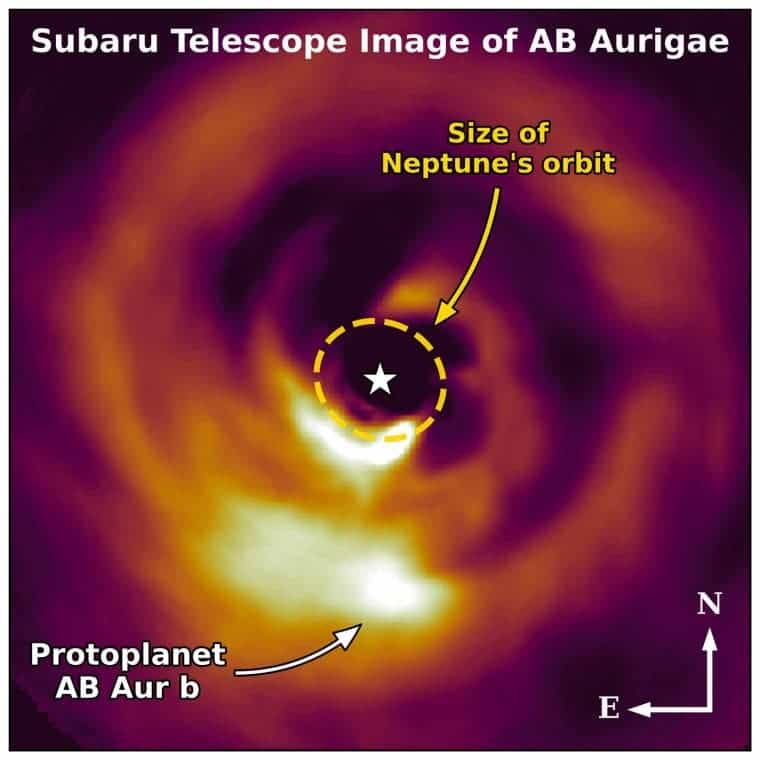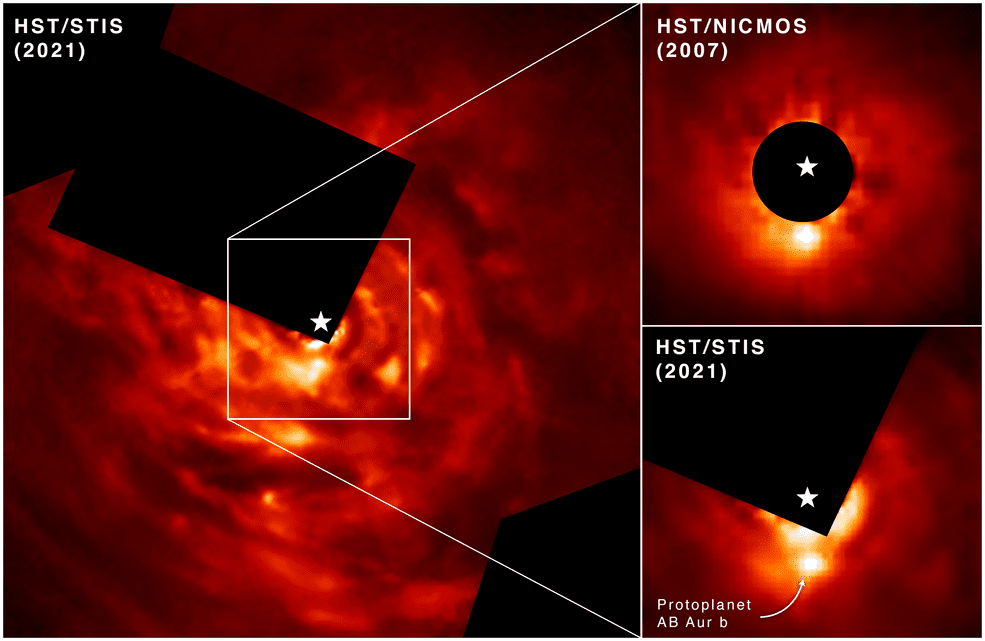For years, astronomers have been keeping an eye on AB Aurigae, a very young star no more than 4 million years old located nearby, about 560 light-years from Earth. Considering the Sun is more than 4.5 billion years old, AB Aurigae is still like a fetus. Indeed, the star is still in its development phase, not quite yet fusing hydrogen and helium in its core. Alongside this fledgling star may lie ‘baby’ planets, providing a rare opportunity to glimpse the early formation of an exoplanet right before our eyes.

In a new study, researchers led by astrophysicist Thayne Currie from the National Astronomical Observatory of Japan employed the massive Subaru telescope in Hawaii and the Hubble Space Telescope to detect one such exoplanet — a huge gas giant more than nine times Jupiter’s mass. The planet, dubbed AB Aurigae b, is still growing and is unique in many ways. One controversial conclusion is that the planet formed after gas collapsed under its gravity, a proposed mechanism of planetary formation known as gravitational or disk instability. This would be the first time that proper evidence has been found for this mode of formation.
A new planet is born
Exoplanet hunting is a relatively new field of astronomy. The first planet outside our solar system was only found in 1992. Fast forward to 30 years later, and now astronomers have confirmed over 5,000 exoplanets. Nearly 99% of these planets were found using the transit method, an indirect method that involves measuring dips in light from a star as a planet passes in front of it. We don’t see a planet itself, but rather the measurable effect it has on the parent star — it’s still a very powerful and useful method though. For instance, if an atmosphere is present on the planet, it can absorb a very tiny bit of light, so the transit method can even reveal which planets have atmospheres and, in some cases, even their composition.
A tiny fraction of exoplanets have been detected by being directly imaged, much in the same way a telescope might observe the movements of a distant moon orbiting Saturn. This was the case for AB Aurigae b too, owing to the fact that its parent star is still very young, so it doesn’t release too much infrared light which would have normally obscured direct imaging of orbiting planets. AB Aurigae b is also very far away from its host star, hovering 14 billion kilometers out — about twice as far as Pluto orbits the Sun. This also greatly helps with direct observation, helping reveal important insights into the gas giant’s formation.

The most widely accepted model for planetary formation is that dust grains accreting in the form of a disk around a young star gradually build up to become large clumps of material known as “planetesimals”. These asteroid-like seedlings gradually grow by colliding with other fragments, much like a snowball gathers more snow as it rolls down a slope, growing increasingly larger. Eventually, the planetesimal reaches hundreds or even thousands of kilometers across, at which point it becomes a protoplanet — an early planet with enough mass to pull in more dust and gas with its own gravity.
However, simulations suggest that at very long distances — such as that of AB Aurigae b from its host star — planets form differently. Planetesimal collisions are very rare this far away from a star, which is why some scientists have proposed alternate modes of formation. For instance, Anders Johansen, an astrophysicist at the University of Copenhagen, has proposed the “pebble accretion” model. This idea suggests that pebble-sized material in the outer disk of gas and dust surrounding a young star is easier to catch and assemble into a bigger object because the movement is slowed down by gas.
But not even the pebble accretion model can explain AB Aurigae b. “I don’t understand how you can have pebble accretion form a nine-Jupiter-mass planet at 93 AU, and it be shining after 2 million years,” Currie says.

Instead, Currie thinks that the gas giant formed via the controversial gravitational instability model. Observations of the planet, which sits on a bright blob in one of the spiral arms of AB Aurigae’s disk, show that the object is illuminated from within — a telltale sign of a protoplanet glowing hot from formation, as opposed to a denser section of dust from the disk that would just have reflected incoming light. And the fact that it appears as a large blob supports disk instability because any planet formed this way would have to be surrounded by a much larger cloud of gas.
“This new discovery is strong evidence that some gas giant planets can form by the disk instability mechanism,” Alan Boss of the Carnegie Institution of Science in Washington, D.C. emphasized. “In the end, gravity is all that counts, as the leftovers of the star-formation process will end up being pulled together by gravity to form planets, one way or the other.”
But not all scientists are convinced. Johansen, for instance, claims that AB Aurigae b’s position in the disk’s spiral arm doesn’t rule out planetesimal creation mechanisms. Yet although this isn’t the final word on the matter, understanding how Jupiter-like planets may form could enrich our understanding of the history of our own solar system.






